REAL SIMPLE![]()
Your Problem:
Dysfunctional Garage
As you’re tripping over paint cans and bumping into rusty sleds, you may not realize that your garage is the most functional space in the house. After all, what other room can serve as workshop, potting shed, storage locker, recycling plant, and carport all at once? But versatility – sadly, inevitably – leads to chaos. And, of course, untangling the chaos (and those 50 feet of bright orange indoor-outdoor extension cord) always takes longer than creating it. Here you’ll find our step-by-step strategy for making your hardest-working space work better. (And wouldn’t it be great if your car fit in there somewhere, too?)
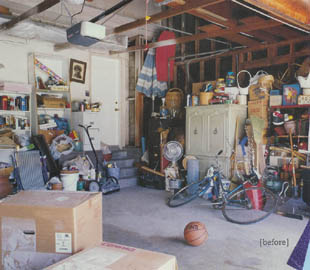
before
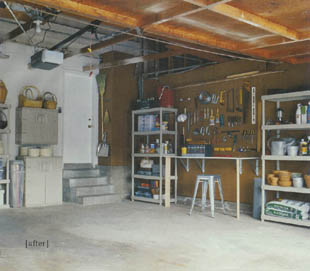
after
The secret to an organized garage is having distinct storage areas. In this 20-by-24-foot garage, spaces have been carved out for sports equipment, general storage (including Christmas decorations, craft supplies, and oversize pots and pans), cleaning supplies and paint, tools, and garden equipment.
Solution #1: Cut the job down to size
Clean out one area at a time instead of tackling the whole mess at once. Do what you can when you can. You don’t need to devote an entire weekend to the project. When you have an hour, sort a couple of shelves or two boxes of old clothes. When you have a day, sort a whole wall.
Solution #2: Arm yourself
Organizing a garage is a messy, time-consuming job. And if you’re doing it right, you’ll end up with a lot of things to throw away, give away, and get repaired. Before plunging in, gather heavy-duty 33-gallon plastic garbage bags, 6 to 10 large cardboard boxes (but not so large that you won’t be able to move them when they’re full), a marking pen to label boxes, a roll of packing tape to seal boxes, a box cutter to cut down any old boxes you empty as you organize, and a ball of twine to tie up newspapers, magazines, and cut-down boxes.
Solution #3: Sort and purge
- Pick a corner for sorting and then line up three boxes (first reinforce the bottoms with packing tape). Label one GIVE AWAY, one REPAIR, and one NOT SURE. Set up a trash bag for the things you’re going to throw away.
- Start pulling out items one at a time. Look at each item and ask yourself if it’s something you need, want or use. If the answer is no, put it in the trash bag or the giveaway box. If the answer is yes but it’s broken and you’re going to fix it yourself, put it in the repair box. If you’re going to take it to someone else to be repaired, put it in your car. (Six weeks later, don’t let it find its way out of the car and back into the garage unrepaired.)
- Put items that are in working order on the floor in the center of the garage. As these items start to accumulate, sort them into piles. For instance, all the tools in one pile, garden equipment in another, sports equipment in another. Eventually, you’ll create a separate storage area for each of these piles.
- Fill the “not sure” box as you go. But remember that you’ll have to decide what to do with everything sooner rather than later.
- As boxes and trash bags fill up, seal them and take them out of the garage so you have more room to work. (Cover with tarps if you have to.)
- If you have things stored in the rafters, sort them last.
- Though there’s no telling how long sorting and purging will take, it will be easier and go faster if you concentrate on one small area at a time and sort it completely before moving on.
Solution #4: Purge one more time
After you sort, you’ll be left with a number of piles in the center of your garage. They’ll reflect your lifestyle, interests, and hobbies. Look through each pile. What you find may surprise you. Did you know you had six tennis rackets? Maybe one or two of those should go in a give-away box. The more things you get rid of, the fewer you’ll have to put back.
Solution #5: Designate Storage Areas
- Once you’ve winnowed down your piles to the keepers, you’re ready to create a storage area for each one. In general, plan to store things you use regularly, like cleaning products, closest to the door to the house. Store items you use outside, like garden equipment, closest to the garage door.
- After you’ve figured out which pile is going where, you’ll need to determine just how you’re going to store things. Items you use regularly, like oversize pots and pans, bulk groceries, and craft supplies, are best kept on open shelves. Closed-door storage is best for hazardous items such as cleaning supplies and solvents, particularly if you have children. Hand tools and garden equipment can be hung from wall-mounted hooks or racks, as can sports equipment such as Boogie boards and skis. Not only are things easy to see when they’re hung high but you’ll also free up floor space for parking.
- Relegate those things you use once a year or less frequently – Christmas decorations, old yearbooks – to overhead rafters or the uppermost reaches of shelves.
Solution #6: Recycle, buy or build
- Though you may be tempted to buy storage products early on in the process (after all, it’s the fun part), don’t. It’s impossible to gauge what you’ll need until you figure out exactly what you’re going to store and where you’re going to store it. Look at your piles carefully and then decide how many boxes, shelves, and hooks you’ll need.
- Stores and websites selling all manner of storage products are plentiful, but you can keep costs to a minimum by repurposing old furniture. For example, move an outdated hutch from the spare room into the garage to provide closed-door storage, or use an old table as a workbench. You can also lay plywood boards on galvanized brackets nailed into studs.
- Transparent plastic boxes and bins are ideal for small items like sewing and crafts supplies because you can see what’s stored inside. But carefully labeled cardboard boxes from the liquor store work just as well.
- Labeling tip: “SUZY’S ARTS AND CRAFTS SUPPLIES” is better then “SUZY”; “TAXES 1998” is better than “TAXES.”
- After you’ve neatly stowed the contents of all your piles in your storage areas, the dirty work, thankfully, is done.
Solution #7: Donate and dispose
- The pile of trash bags and giveaway boxes may look alarming, but a few phone calls – and a few trips to the dump – should dispatch it all.
- For trash: Put out regular trash bags with your weekly garbage pickup. If you have too much for one pickup, divide it over a couple of weeks. You’ll have to make special arrangements for large items, like furniture, as well as for hazardous waste, like motor oil, paint, paint thinner, pesticides, and car batteries. Call your local sanitation department or your local office of solid waste and recycling for information, or visit www.1800cleanup.org. The Steel Recycling Institute (www.recycle-steel.org) will take household appliances such as air conditioners, washing machines, and dryers.
- For donations: The Salvation Army (www.salvationarmy.org) and Goodwill (www.goodwill.org) accept many types of goods and in a lot of areas will pick up donations. For other groups that may benefit from your donations, visit the “advanced search” area of www.guidestar.org.
Solution #8: Tie up the loose ends
Revisit your “not sure” boxes. With a clear head and a clean garage, you may feel less nostalgic about those old Legos. If so, send them to the curb. Otherwise label the boxes and stow them in the appropriate storage area.
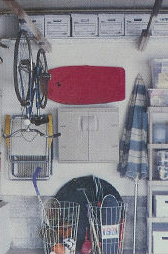 SPORTS AREA: Sports equipment gets stowed in a Rubbermaid wall cabinet, and toy barrels. The Boogie board rests on brackets (about $3 each at home centers), and the bike is hung on hooks.
SPORTS AREA: Sports equipment gets stowed in a Rubbermaid wall cabinet, and toy barrels. The Boogie board rests on brackets (about $3 each at home centers), and the bike is hung on hooks.
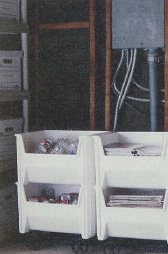 RECYCLING AREA: Stacking bins keep recyclables tidy; wheels make bins mobile, for easier trips to the curb.
RECYCLING AREA: Stacking bins keep recyclables tidy; wheels make bins mobile, for easier trips to the curb.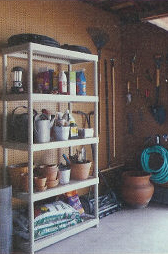 GARDEN AREA: Cover unfinished walls with four-by-eight foot sheets of quarter-inch pegboard so you can hang tools. If walls are finished with Sheetrock, mount tool racks instead.
GARDEN AREA: Cover unfinished walls with four-by-eight foot sheets of quarter-inch pegboard so you can hang tools. If walls are finished with Sheetrock, mount tool racks instead.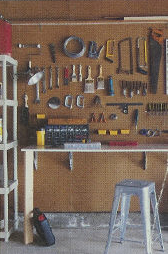 TOOL AREA: Hang hand tools so you can see them. Pegboard can be screwed directly to the studs on unfinished walls. Dan Lipman & Associates offers a system for finished walls. The 5 ½ – by 2-foot worktable is made from melamine mounted on brackets, with two-by-four legs. Thirty-six-drawer chest for organizing hardware.
TOOL AREA: Hang hand tools so you can see them. Pegboard can be screwed directly to the studs on unfinished walls. Dan Lipman & Associates offers a system for finished walls. The 5 ½ – by 2-foot worktable is made from melamine mounted on brackets, with two-by-four legs. Thirty-six-drawer chest for organizing hardware.
TIPS FROM THE TRENCHES
Linda Rothschild, founder and CEO of Cross It Off Your List, a Manhattan-based organizing service, and the president of the National Association of Professional Organizers, offers sage advice for the novice garage organizer.
-
On separation anxiety:
“To really get organized, it helps to eliminate things. If that’s difficult for you, keep in mind that somebody else could use the items that are going to waste in your garage.”
-
On teamwork:
“Try to enlist family members. In the future, they may think twice about dumping things in the garage after they’ve spent the time to sort it out.”
-
On rules:
“There are no rules. Arrange things where they work best for you.”
-
On the time commitment:
“There’s no way around it. Organizing the garage is time-consuming. But what you’ll save on the back end will be invaluable – you’ll be able to find things instantly.”
-
On staying organized:
“You may have trouble keeping it up on a daily basis, but shoot for a yearly or biyearly clean-up.”
PRODUCED AND WRITTEN BY KELLY TAGORE
Additional reporting by Christine Camean
PHOTOGRAPHS BY PETER MARGONELLI
